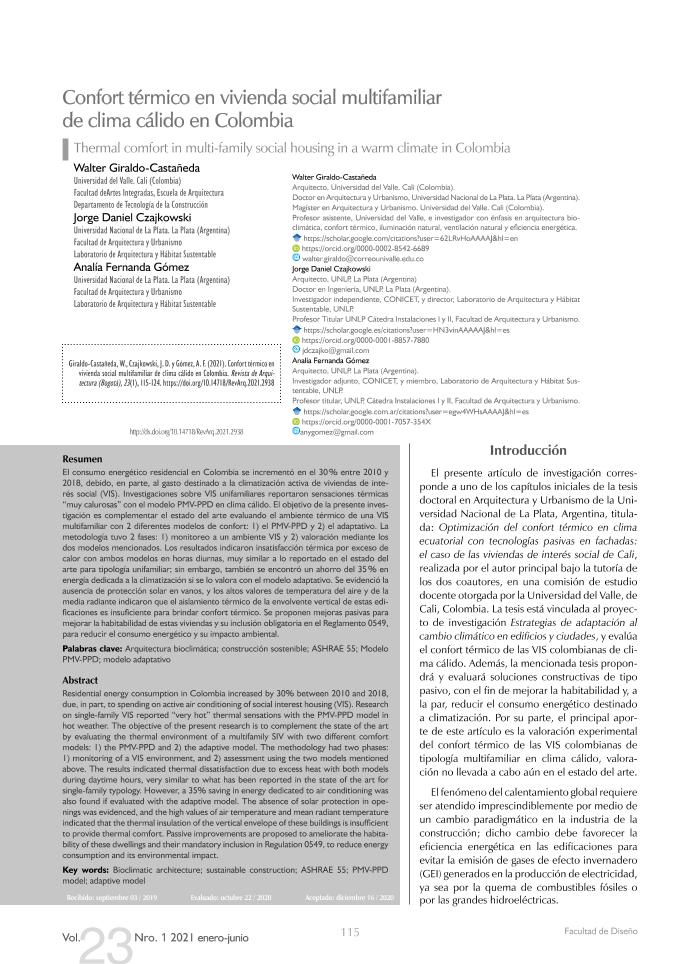Artículo
El consumo energético residencial en Colombia se incrementó en el 30 % entre 2010 y 2018, debido, en parte, al gasto destinado a la climatización activa de viviendas de interés social (VIS). Investigaciones sobre VIS unifamiliares reportaron sensaciones térmicas “muy calurosas” con el modelo PMV-PPD en clima cálido. El objetivo de la presente investigación es complementar el estado del arte evaluando el ambiente térmico de una VIS multifamiliar con 2 diferentes modelos de confort: 1) el PMV-PPD y 2) el adaptativo. La metodología tuvo 2 fases: 1) monitoreo a un ambiente VIS y 2) valoración mediante los dos modelos mencionados. Los resultados indicaron insatisfacción térmica por exceso de calor con ambos modelos en horas diurnas, muy similar a lo reportado en el estado del arte para tipología unifamiliar; sin embargo, también se encontró un ahorro del 35 % en energía dedicada a la climatización si se lo valora con el modelo adaptativo. Se evidenció la ausencia de protección solar en vanos, y los altos valores de temperatura del aire y de la media radiante indicaron que el aislamiento térmico de la envolvente vertical de estas edificaciones es insuficiente para brindar confort térmico. Se proponen mejoras pasivas para mejorar la habitabilidad de estas viviendas y su inclusión obligatoria en el Reglamento 0549, para reducir el consumo energético y su impacto ambiental. Residential energy consumption in Colombia increased by 30% between 2010 and 2018, due, in part, to spending on active air conditioning of social interest housing (VIS). Research on single-family VIS reported “very hot” thermal sensations with the PMV-PPD model in hot weather. The objective of the present research is to complement the state of the art by evaluating the thermal environment of a multifamily SIV with two different comfort models: 1) the PMV-PPD and 2) the adaptive model. The methodology had two phases: 1) monitoring of a VIS environment, and 2) assessment using the two models mentioned above. The results indicated thermal dissatisfaction due to excess heat with both models during daytime hours, very similar to what has been reported in the state of the art for single-family typology. However, a 35% saving in energy dedicated to air conditioning was also found if evaluated with the adaptive model. The absence of solar protection in openings was evidenced, and the high values of air temperature and mean radiant temperature indicated that the thermal insulation of the vertical envelope of these buildings is insufficient to provide thermal comfort. Passive improvements are proposed to ameliorate the habitability of these dwellings and their mandatory inclusion in Regulation 0549, to reduce energy consumption and its environmental impact.
Confort térmico en vivienda social multifamiliar de clima cálido en Colombia
Título:
Thermal comfort in multi-family social housing in a warm climate in Colombia
Fecha de publicación:
09/2021
Editorial:
Universidad Católica de Colombia
Revista:
Revista de Arquitectura
ISSN:
1657-0308
e-ISSN:
2357-626X
Idioma:
Español
Tipo de recurso:
Artículo publicado
Clasificación temática:
Resumen
Palabras clave:
CONFORT TÉRMICO
,
VIVIENDA SOCIAL
,
CLIMA CÁLIDO
,
COLOMBIA
Archivos asociados
Licencia
Identificadores
Colecciones
Articulos(CCT - LA PLATA)
Articulos de CTRO.CIENTIFICO TECNOL.CONICET - LA PLATA
Articulos de CTRO.CIENTIFICO TECNOL.CONICET - LA PLATA
Citación
Giraldo, Walter; Czajkowski, Jorge Daniel; Gomez, Analia Fernanda; Confort térmico en vivienda social multifamiliar de clima cálido en Colombia; Universidad Católica de Colombia; Revista de Arquitectura; 23; 1; 9-2021; 115-124
Compartir
Altmétricas




